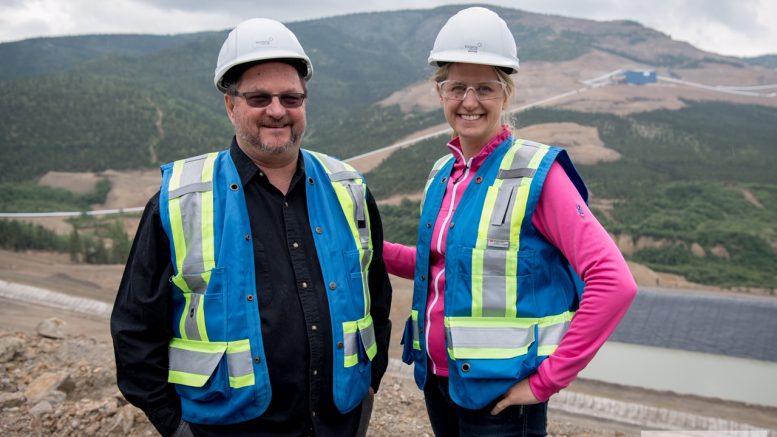Victoria Gold (TSX: VGCX) says an agreement with a syndicate of banks for a secured US$200 million debt facility will cut carrying costs by about 50% in 2021. The credit facility consists of a US$100 million term loan and a US$100 million revolving facility.
The loan was used to repay the company’s previously outstanding project finance facility, which included senior and subordinated debt that was used to build Victoria Gold’s Eagle gold mine in the Yukon.
The Eagle mine, 375 km north of Whitehorse, became the Yukon’s newest gold mine when it reached commercial production in July 2020. Eagle is forecast to produce an average of 210,000 oz. gold a year over ten years.
The loan facility has an interest rate ranging from 3% to 4% over LIBOR, or US dollar base rate loans, with an interest rate ranging from 2% to 3% over the US base rate, each based on the company’s leverage ratio and other terms and conditions.
The loan facility features lower interest rates, which is anticipated to reduce carrying costs by approximately 50% in 2021, John McConnell, Victoria Gold’s president and CEO, said in an interview. “The key thing for me is it’s a savings of about $10 million Canadian dollars so fairly significant.”
It also gives the company greater flexibility because it can draw and repay the revolving credit facility as needed, and also offers “more latitude with respect to permitted distributions including investments, share buybacks and dividends.”
McConnell pointed out that prior to repaying the project facilities, Victoria Gold had paid over US$54 million in principal and interest against the original project construction facilities, and said the company expects to generate enough free cash flow to continue to pay down “material amounts” of debt during calendar 2021.

Loading ore into a haul truck at the Eagle gold mine. Credit: Victoria Gold.
The company says the term facility will be repaid in 12 equal quarterly installments starting at the end of the first quarter of this year. Any outstanding amounts on the revolving credit facility will repayable as a bullet on the maturity date, which is extendable, and any unused portion is subject to customary commitment fees. The loan facility matures in December 2023.
The company has also reported production results of 77,748 oz. gold for the first six months of commercial production (July-December), above its guidance of of 72,000-77,000 ounces. Fourth quarter production totalled 42,174 ounces. Ore placement on the heap leach pad increased by more than 20% quarter over quarter, including more than 1 million tonnes of mineralized material on the pad in December.
“We stumbled a bit in the third quarter, we had some production problems, and certainly we have got more work to do on our plant, but I think the turnaround is there and we’ll continue to improve over the coming quarters,” he said.
In other recent news, the company was added to the VanEck Vectors Junior Gold Miners ETF (GDXJ) in mid-December. “We finally met all their criteria,” McConnell said. “Part of the reasoning for having Orion do a secondary offering of Victoria’s stock in the fall was to reduce their ownership from about 40% to below 40%, which is not a hard and fast rule of the index funds, but they don’t like to see a shareholder over 40%.”
On the exploration front, Victoria Gold released more results last month from its 555 sq. km Dublin Gulch property, which hosts the Eagle and Olive gold deposits. (The Eagle and Olive deposits have proven and probable reserves of 155 million tonnes grading 0.65 gram gold per tonne for 3.3 million ounces.)
They were the first exploration results from the company’s Lynx target, one of several areas of interest along the Potato Hills Trend, which hosts a mineralized corridor within the greater Dublin Gulch gold camp.
The results included four diamond drill holes (590 metres) and six trenches (720 metres) and the collection of more than 1,600 grid based soil geochemical samples.
Highlights from the drilling at Lynx were 0.49 gram gold per tonne over 153.8 metres from surface in drillhole LX20-021C, including 6.14 grams gold per tonne over 8.4 metres from 23.3 metres; and 11.9 metres grading 1.26 grams gold from surface in drillhole LX20-022C, including a 13.5 metre intercept of 1.12 grams gold starting from 141.3 metres downhole.
Results from trenches included 4.65 grams gold over 32 metres and 1.35 grams gold over 80 metres in TRLX20-5; 3.33 grams gold over 16 metres in TRLX20-4; and 1.62 grams gold over 46 metres in TRLX20-1.
The Lynx target has similar characteristics to the company’s Raven target, about 5 km away. The two targets are about 15 km from the company’s producing Eagle mine.
“It’s fairly early days on Lynx but there was a previous operator who had done some exploration there and during the winter last year we mined the data and concluded they were exploring it all wrong and so we went back and did a limited amount of trenching and drilling, and now we think we understand it way better and will be back out there in the summer.”
McConnell forecasts the company’ will drill a total of between 10,000 and 15,000 metres this year. Raven is the company’s number one exploration target.
Victoria Gold has a market cap of about $792 million. It has roughly 62 million common shares outstanding and at presstime was trading at $12.80 per share. Over the last year the company has traded in a range of $4.02 and $21.04 per share.


Be the first to comment on "Victoria Gold’s new credit facilities expected to lower carrying costs in 2021"